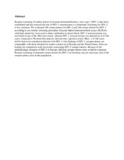| dc.contributor.author | Geier, SA | |
| dc.contributor.author | Klauss, V | |
| dc.contributor.author | Gürtler, L | |
| dc.date.accessioned | 2013-06-18T07:42:25Z | |
| dc.date.available | 2013-06-18T07:42:25Z | |
| dc.date.issued | 1994-05 | |
| dc.identifier.citation | Ger J Ophthalmol. 1994 May;3(3):182-5. | en |
| dc.identifier.uri | http://hinari-gw.who.int/whalecomwww.ncbi.nlm.nih.gov/whalecom0/pubmed/7864930 | |
| dc.identifier.uri | http://erepository.uonbi.ac.ke:8080/xmlui/handle/123456789/35394 | |
| dc.description.abstract | Routine screening of cornea donors for human immunodeficiency virus type 1 (HIV-1) has been established and has reduced the risk of HIV-1 transmission to a minimum. Screening for HIV-2 is less common. We evaluated 100 cornea donors for HIV-2 and 166 cornea donors for HIV-1 according to our routine screening procedure. Enzyme-linked immunosorbent assays (ELISAs) with high sensitivity were used to detect antibodies in donor blood. HIV-2 seroconversion was not found in any of the 100 cases tested, whereas HIV-1 seroconversion was detected in 4 of 166 cases; consecutive Western-blot analysis showed only 1 positive result. Thus, 1 of 166 cases (0.6%) had to be considered infected with HIV-1. Our findings of HIV-1 seroprevalence are comparable with those obtained in studies carried out in Europe and the United States. Data are lacking for comparison with our results concerning HIV-2 seroprevalence. Because of the epidemiologic situation of HIV-2 in Europe, different seroprevalence rates would be expected. Routine screening of potential cornea donors for HIV-2 in Germany may be necessary only if the seroprevalence rises in the population. | en |
| dc.language.iso | en | en |
| dc.publisher | University of Nairobi | en |
| dc.title | Human immunodeficiency virus type 1 and type 2 seroprevalence in cornea donors. | en |
| dc.type | Article | en |
| local.publisher | College of Health Sciences | en |

